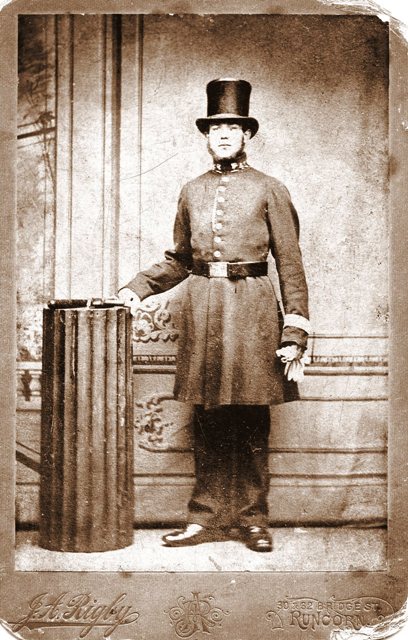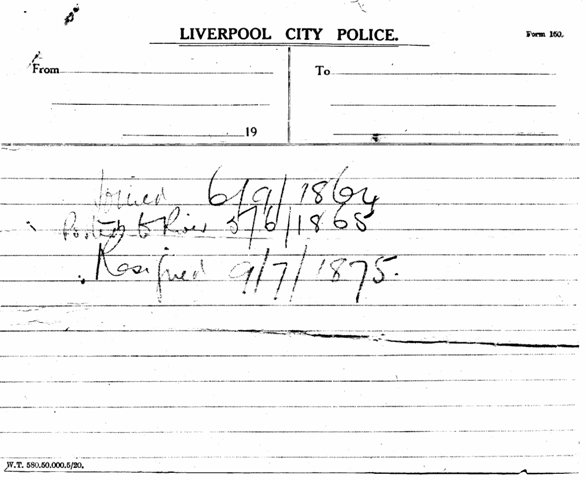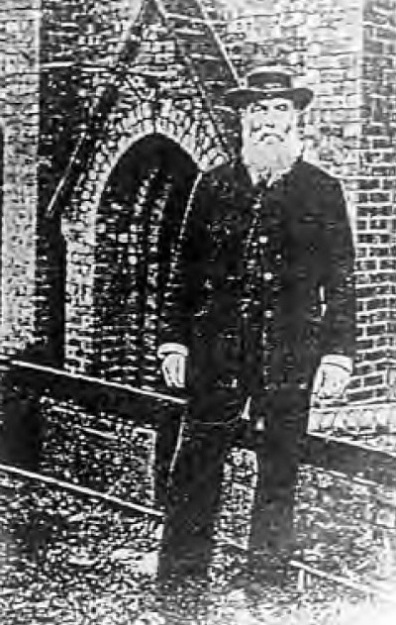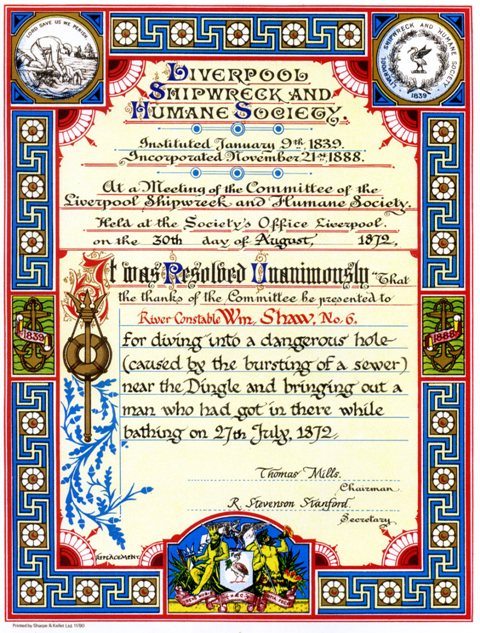The men of the Liverpool Town Dock Police and Liverpool River Police In particular River Constable 6 William Shaw –
“A Man of Runcorn – His Life and Times “
By John Hutchinson Retd.
William Shaw was born on Friday 16th September 1842 in Upton-on Sea. He was registered ‘Richard’ by his Mother Abigall who named him after her brother. Later he was baptised as ‘William’ by the family.
At the age of 11 years he went off to sea as a cabin boy. He sailed the seven seas visiting Spain, Russia and Auckland and spent time at sea on emigrant ships. Other voyages took him to Australia, where he worked in the bush and studied the Aborigines way of life, and China where he witnessed the Taiping Rebellion, in which 20 million Chinese people died. He also saw the attack on Shanghai in August of 1860.
Later William joined the Royal Navy and served on both HMS Saracen and HMS Pioneer. He was discharged from the Royal Navy in 1863.
William Shaw and his Police Service :–
On Tuesday 6th September 1864 he joined the ‘Liverpool Corporation Borough Police’ and on Monday 5th June 1865 was posted to the River Police. On Sunday 6th August that same year he was married at St Johns Church, since demolished and now the site of St Johns Gardens in Liverpool.
At that time River Constable William Shaw was residing at 35 Vickers Street in the Toxteth area of Liverpool. At about the same time of his appointment in the early 1860s – the Borough of Liverpool was reported to have 982 police staff, at an annual cost of £66,127 of which £14,576 came from the national treasury.
In the 1860s – River Constable 6 William Shaw and other members of the Liverpool River Police would have had a different view of the River Mersey than we have today.
The idea and commercial concept put forward “By the Men of Manchester” to bypass the Port of Liverpool and build the Manchester Ship Canal had not even been conceived. The “Gentlemen of Liverpool “ had a strong hold on the River Mersey’s trade.
Likewise In those times of early policing, small villages and fishing communities that lead to the sandy banks of the River Mersey and River Weaver would rely on the rivers to trade and communicate. Places such as Warrington, Runcorn and Frodsham were also ports on the River Mersey and had tidal access to the Irish Sea via the River Mersey – but ‘Liverpool and the Port of Liverpool’ had become the new masters of the River. The developing Town of Liverpool held firm rule on the River Mersey and places such as Runcorn had become part of the extended Port of Liverpool. This situation prevailed till the 5th April 1847 when Runcorn was designated an Independent Customs Port. However that status was short lived. On the 16th April 1850 Runcorn was reduced to its former status under the Port of Liverpool.
The coming of canals and railways would all go to ensure that the Town of Liverpool’s future would result in it becoming the second ‘City of the British Empire’ and this happened in 1880 when it became a City. The small town of Liverpool had become a Borough in 1207 during the Reign of King John.
With the opening of the Manchester Ship Canal in 1894 the policing function of the Runcorn docks was in the hands of the ‘Port of Manchester Ship Canal Police’ – while the town of Runcorn was policed by the Cheshire Constabulary. The Port of Manchester Canal Police members were a familiar sight patrolling Salford and Runcorn – an operational situation that took place up to the disbandment of the force in 1993. The sight of an armed Manchester Dock Policeman was not unusual during WW2 and well into the late 1950s.
Prior to the 1860s – those active in criminal matters on the River Mersey would fear only the “Customs & Excise Men” or the members of old ‘Liverpool’s Dock Police’ – incorporated into the ‘Liverpool towns Borough Police Force’ in 1836. The operational records of the Liverpool Dock Police and details about the men employed have long since done. However – men such as Superintendent Enoch Broadley, Dock Constables William Brown and Joseph Burnley are recorded as being members of the force at that time.
Another man from that time was Police Captain John Audley of the Liverpool Dock Police. He died on the 28th December 1826 – his death being recorded in the Friday 6th January 1827 edition of ‘The Liverpool Mercury Newspaper’ stating him to be “A man who exercised the duties appertaining to his office in the most respectful manner “
The ‘Liverpool Dock Police’ had been established after a 1762 Act of Parliament handed control of Liverpool’s Docks to the Liverpool Town Corporation. The Docklands in those times were wide open for all – including organised gangs and thieves. In 1819 a serious affray took place in the town which involved the Dock Police and members of the Irish community.
With the appointment in 1836 of Wexford born Michael James Whitty as Liverpool’s first ‘Head Constable’ members of the Dock Police such as Superintendent Enoch Broadley would have made up the ranks of the new Liverpool Police force.
The question of the ‘Liverpool Dock Police’ and the new ‘Liverpool Borough Police’ was subject of a debate in the House of Commons on Friday 24th June 1836.
The proposal was to have two separate police forces in Liverpool – which was opposed by the Liverpool member the Rt. Hon. William Ewart (1798 -1869 ) the son of ‘William Ewart of Liverpool’ and a close friend of Liverpool’s William Huskisson
Opinion was presented by Sir Richard Mayne the Chief of the London Metropolitan Police as to how Liverpool Town should be policed – amalgamation of the Town and Dock Police being his opinion.
Note: – After one hundred and thirty years The Mersey Docks and Harbour (Police) Order 1975 was passed and the ‘Liverpool Docks Police’ was again reformed. The force known as ‘Liverpool Port Police’ is vested with authority and jurisdiction along both sides of and the Manchester Ship Canal to Salford.
Well before the 1860s many of the communities bordering onto the sandy beaches of the River Mersey had historically, folk among them involved in ship wrecking and pillaging – a way of life uninterrupted for centuries on the Cheshire side of the River Mersey.
The sight to witnessed by Cheshire men of rowing boats manned full of “River Police Coming from the Town of Liverpool Over the Water” may not have been well received by some of them. It is known that Constables from Liverpool had been sent to the Frodsham and Helsby in Cheshire because of the activities of ship wreckers operating on the River Mersey banks in those areas.
Under the provision of the various Liverpool Corporation Acts Liverpool Town extended it power and commercial influence in many ways, including the powers and jurisdiction of the Towns Constables – and the River Mersey was included in the extension of that role.
Officers like River Constable William Shaw helped to bring law and order to the River Mersey, often appearing in the rowing boats out of the mist to board ships and deter criminals operating on the river.
The Liverpool River Police detachments used boats that were rowed or sailed. Often the River Police boats became stranded against the Mersey’s tides and were helped by passing steamers.
River Constable William Shaw’s bravery was also acknowledged when on Friday 30th August 1872 he was presented with a “Liverpool Shipwreck and Humane Society Certificate” which read :-
“ To River Constable Wm Shaw No 6 for diving into a dangerous hole ( caused by the bursting of a sewer) near Dingle and bringing out a man who had got in there while bathing on 27th July 1872”
Many other local stories are told about his bravery – such as the time he was on night duty at Runcorn and dived into the River to rescue a woman. He continued the remainder of his tour of duty in his wet uniform. He later went down with pneumonia and his wife was told by the doctor to fear the worst with little chance of recovery – but he did recover demanding a hot bath.
River Police Constable 10 William Pegler was another outstanding brave member of the River Police. During the 1870s he was credited with eight recorded gallant rescues on the River Mersey and received many awards from the ‘Liverpool Shipwreck and Humane Society ‘– An outstanding achievement by a very brave man, maybe never to be equalled by any other Liverpool Constable.”
In February of 1868 River Constable 10 William Pegler was called to give evidence before Mr Clarke Aspinall Liverpool’s Borough Coroner.
His opinion was called for at the Inquest into the death of River Constable No 1 Henry Madden. River Constable Pegler was asked about the design of boats used by the River Police, he replied “They would be better if they were a little higher out of the water “ The officers opinion and observation was agreed by the Coroner’s Jury.
William Shaw’s friend River Constable Number 1 Henry Madden had drowned on Monday 3rd February 1868 when the River Police boat capsized in the River Mersey.
River Constables William Shaw, John Jones, Peter Ball, John Gillespie and Samuel Litter were on the boat when the incident took place in the river on the Cheshire side between Rock Ferry and Tranmere .
Other known officers who served as members of the River Police at about that time :-
River Constables :-
MacBride.
John Elliot,
George Robertson
William Stuart,
John Baker
Timothy Reylands.
Many of those men received awards from the “Liverpool Shipwreck and Humane Society “while serving with the Liverpool River Police.
Life continued for Constable William Shaw, but on Thursday 9th July 1875 he resigned from the force. His resignation was five years before the Town Borough of Liverpool became the City of Liverpool. The formation of the ‘Liverpool City Police’ followed in the same year.
It’s said by his family that his resignation was prompted by the life threatening experience when his vessel capsized and his colleague River Constable Henry Madden was killed.
To this day William Shaw is not remembered as a Liverpool Policeman by the folk of Runcorn, but as the man who established the “Mersey Mission for Seaman “ in Runcorn Town. The Mission was at first located in the Old Customs House at the Bottom Locks of the Bridgewater Canal. Much later the Mission was relocated to Station Road adjacent to Runcorn’s Waterloo Bridge. William continued his missionary work till he retired in 1922 at the age of 79 years.
William Shaw passed away on Friday 4th June 1926 and was interned in Runcorn Cemetery, located on Greenway Road. His grave is not far from those of two Runcorn men – Private Tom Moffatt and Private Tom Taylor who were at Rorkes Drift during the Zulu War.
John Hutchinson
August 2011

Constable William Shaw is seen in the photograph wearing a ‘Peelers Patrol Hat’ and holding his baton. His high neck tunic collar displays two Liver Bird badges and his force number 73 is attached to tunic collar.
Such an early photograph of a Liverpool Bobby is a very rare item to view and research. Most similar photographs of Liverpool Bobbies of that period have been lost to all.

Sadly such historical documents, alongside those of the great English writer Charles Dickens, (while I and others say he may have been a ‘Dock Constable’ some claim he was a ‘Special Constable’) may all have been destroyed at the time of the formation of the Merseyside Police Force.
John Hutchinson

Acknowledgment:-
I wish to thank the following who have enabled me to produce this article about William Shaw and his time with both the Liverpool Town Police and the River Police — Mr David Sterry Chairman and Mr Ross Bullock Secretary of the Runcorn Historical Society. A special thank you to William Shaw’s great grandson Peter Shaw and relatives the Popplewell family of Runcorn.
A special thank you to the Webmasters of the ‘Old-Mersey Times website’ who continue to ensure that Liverpool’s day to day history is available to all – thank you.
It has been a pleasure and an honour for me to have researched Runcorn’s William Shaw and his place in Liverpool’s policing history
Finally – I remember a close friend the late Herbert Starkey of Halton Village Runcorn, a respected historian and writer and founder member of the Runcorn Historical Society. He wrote many historical books, including “Schooner Port” which ensured the history of the upper River Mersey was recorded for all.
It was Bert Starkey who observed the following about ‘William Shaw A man of Runcorn’:–
“ If ever a man deserved to be remembered it was William Shaw “ –
.
John Hutchinson
11th August 2011
To learn more about William Shaw please visit the ‘Runcorn Historical Society’ website.


